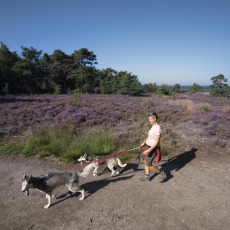The high, dry sandy soil was mainly planted with Scots pine up to the end of the last century, with the addition of larch and Douglas fir over the last few decades. A varied forest formed over the years due to spontaneous growth of birch, oak and beech trees. The more open deciduous forests have a shrub layer of rowanberries, alder buckthorns and buckthorns.
Rhododendrons
The rhododendron has a massive local presence. For years, this shrub was cultivated at the foot of the Sprengenberg and also dispersed across the area beyond the former nursery. The shrub layer hides a very varied herb layer, with rare plants such as polygonatum and false lily of the valley. Peculiar is the presence of blueberries and lingonberries, and cowberries where the forest meets the heathland. Especially in winter, these cowberries are essential for black grouse and other animals that feed off berries.
A few marshes, mainly to the west, have been returned to former glory in recent years by the Society for the Preservation of Nature. One of these is the Fazantenweide, a plot visible to the public from the footpaths. Due to their vulnerability, other marshes are not open to the public.
Fazantenweide (Pheasant’s Meadow)
In 1996, the Society for the Preservation of Nature transformed de Fazantenwei - a 3-hectare plot of grassland - into a habitat for amphibians such as the moor frog and crested newt. The top layer of soil was removed from the grassland, creating a much wetter terrain. This process also benefits birds and mammals such as badgers and deer due to the year-round standing water. This quarry-like area is now home to many Red List species such as the crested newt and moor frog, as well as more general species like toads, green frogs and smooth newts.
Coots, little grebes and grey herons are also spotted here regularly, and various types of pioneer plants such as sundews and club moss have returned. Scottish Highlanders come to the water to cool off in summer. Even though water levels have dropped by almost one metre over the last century, the pond is deep enough to hold water all the time.
Eendenplas (Duck pond)
The Sprengenberg also features several marshes, like the Eendenplas and the kleine plas (small pond). These are acidic waters: essential for various species of dragonfly and the moor frog, but too acidic for other amphibians. The paths are well away from these waters, they are not open to the public. There is also a raised bog in the area, but it is not open to the public, due to its vulnerability.










